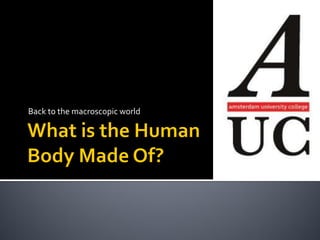
Back to Macroscopic World: Nuclear Fusion in the Sun
- 1. Back to the macroscopic world
- 2. Big Questions in Science, fall 2012. SdH, AUC 2
- 3. Week 3a Nuclear fusion within the Sun: • Proton: positively charged, found in nucleus of the atom • Neutron: neutral, found in nucleus of atom • Positron: positive charge, antiparticle of electron • Neutrino: neutral, interacts only weakly, small mass • Gamma ray: highly-energetic photon Big Questions in Science, fall 2012. SdH, AUC 3
- 4. Big Questions in Science, fall 2012. SdH, AUC 4
- 5. Hydrogen Helium Carbon Proton Alpha Produced in Beta decay particle supernovae Nuclear fusion in the sun and early big bang nucleosynthesis 3 minutes H+H He Alpha decay 5
- 6. Big Questions in Science, fall 2012. SdH, AUC 6
- 7. 99 % consists of: Oxygen Carbon Hydrogen Nitrogen Calcium Phosphorus 98 % of matter in the universe is hydrogen and helium Big Questions in Science, fall 2012. SdH, AUC 7
- 8. Atoms are neutral Number of electrons equals number of protons Nucleus consists of protons and neutrons in (approximately) equal numbers Atomic number (Z): number of protons Mass number (A): number of p+n Number of neutrons (N=A-Z) may vary: isotope 6p+6n 6p+7n 6p+8n Big Questions in Science, fall 2012. SdH, AUC 8
- 9. (99,3 %) (0.7 %) Isotopes have similar chemical properties. Big Questions in Science, fall 2012. SdH, AUC 9
- 10. Atomic number, Z Atomic weight (close to A) Big Questions in Science, fall 2012. SdH, AUC 10
- 11. Russian chemist Dmitri Mendeleev in 1869 Illustrates recurring ("periodic") trends in the properties of the elements Big Questions in Science, fall 2012. SdH, AUC 11
- 12. Big Questions in Science, fall 2012. SdH, AUC 12
- 13. Bohr’s model: Nucleus has internal structure: Big Questions in Science, fall 2012. SdH, AUC 13
- 14. Build up of the periodic table based on few simple physical principles: Total number of electrons such that atom is neutral. Electrons in discrete orbits, as in Bohr’s model. Orbit has “quantum number”. Determines: Energy Size of the orbital Big Questions in Science, fall 2012. SdH, AUC 14
- 15. Each orbital specific number of electrons: Pauli exclusion principle: no two electrons in the same state. At most two electrons in each orbital. There are suborbitals, wich give two extra quantum numbers Big Questions in Science, fall 2012. SdH, AUC 15
- 16. Total: : s-orbital. Max: 2 electrons : p-orbital. Max: 6=2x3 electrons : d-orbital. Max: 10=2x5 electrons : f-orbital. Max: 14=2x7 electrons • The quantum states are called orbitals. • States with the same are called shells (have the same energy). • Each orbital has electrons, hence: shell can host electrons shell can host electrons shell can host electrons, etc. • This should give the length of each row of the periodic table (2,8,18, etc.). • There are exceptions due to screening of electrons. The actual lengths are (2,8,8,18, etc.) Big Questions in Science, fall 2012. SdH, AUC 16
- 17. The Periodic Table is based on the observation that an element's chemical properties depend on the number of electrons in its outer shell. You can count to see how many electrons are in the outer unfilled shell. Elements with the same number of electrons in their outer shell are grouped together. Big Questions in Science, fall 2012. SdH, AUC 17
- 18. Big Questions in Science, fall 2012. SdH, AUC 18
- 19. Big Questions in Science, fall 2012. SdH, AUC 19
- 20. Halogens: • Highly reactive, harmful or lethal to biological organisms. • Reactivity due to the atoms being highly electronegative. They can gain an electron by reacting with atoms of other elements. • Fluorine one of the most reactive elements, attacking otherwise inert materials such as glass. Corrosive, highly toxic gas. • Once it does react with something, it bonds so strongly that resulting molecule is very inert and non-reactive. For example, Teflon is fluorine bonded with carbon. • Chlorine and bromine used as disinfectants for drinking water, swimming pools, fresh wounds, dishes, and surfaces. They kill bacteria and microorganisms. Big Questions in Science, fall 2012. SdH, AUC 20
- 21. Atoms (or molecules) in which number of electrons does not equal number of protons. Electrically charged. : has lost one electron. : has gained one electron. 21
- 22. The periodic table is the alphabet or genetic code in which we can write “words”. Big Questions in Science, fall 2012. SdH, AUC 22
- 23. Atoms Letters Periodic table Alphabet Molecules Words Big Questions in Science, fall 2012. SdH, AUC 23
- 24. Next level of complexity: the Questions ofScience, fall 2012. SdH, AUC Big words in chemistry (molecules) become the letters of biology. 24
- 25. Big Questions in Science, fall 2012. SdH, AUC 25
- 26. Subatomic particles Atom: nucleus and electrons. Strong and electrical force. Molecules. Periodic table. Electrical force. Emerging: van der Waals forces between molecules. Substances, tissues. Electrical force. Big Questions in Science, fall 2012. SdH, AUC 26
